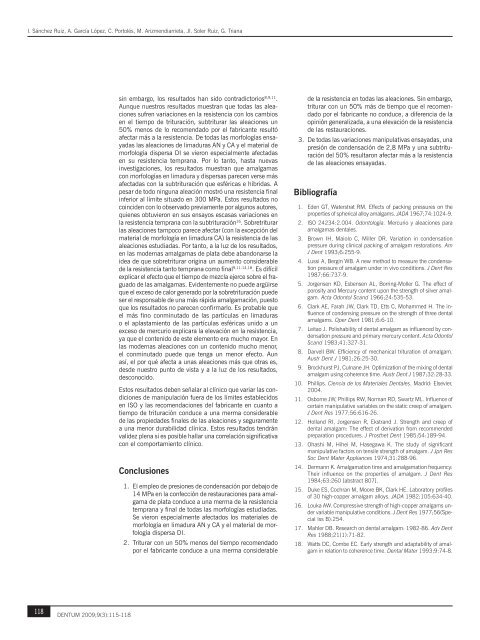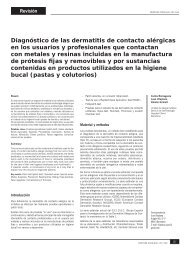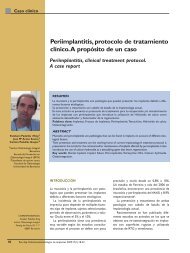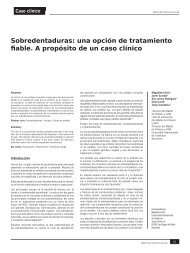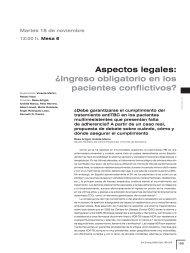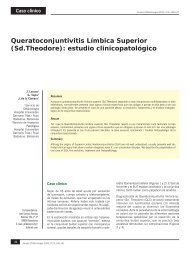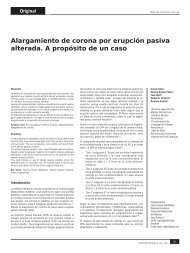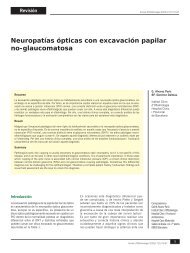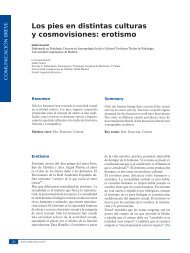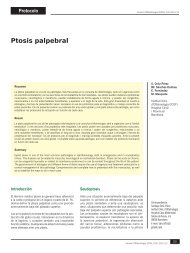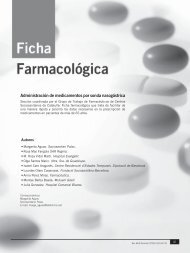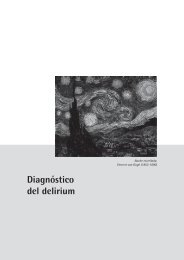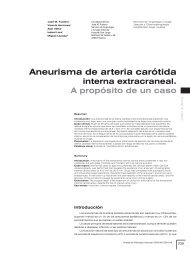Influencia que ciertas condiciones de manipulación ejercen sobre la ...
Influencia que ciertas condiciones de manipulación ejercen sobre la ...
Influencia que ciertas condiciones de manipulación ejercen sobre la ...
You also want an ePaper? Increase the reach of your titles
YUMPU automatically turns print PDFs into web optimized ePapers that Google loves.
I. Sánchez Ruiz, A. García López, C. Portolés, M. Arizmendiarrieta, JI. Soler Ruiz, G. Triana<br />
118 DENTUM 2009;9(3):115-118<br />
sin embargo, los resultados han sido contradictorios8,9,11 .<br />
Aun<strong>que</strong> nuestros resultados muestran <strong>que</strong> todas <strong>la</strong>s aleaciones<br />
sufren variaciones en <strong>la</strong> resistencia con los cambios<br />
en el tiempo <strong>de</strong> trituración, subtriturar <strong>la</strong>s aleaciones un<br />
50% menos <strong>de</strong> lo recomendado por el fabricante resultó<br />
afectar más a <strong>la</strong> resistencia. De todas <strong>la</strong>s morfologías ensayadas<br />
<strong>la</strong>s aleaciones <strong>de</strong> limaduras AN y CA y el material <strong>de</strong><br />
morfología dispersa DI se vieron especialmente afectadas<br />
en su resistencia temprana. Por lo tanto, hasta nuevas<br />
investigaciones, los resultados muestran <strong>que</strong> amalgamas<br />
con morfologías en limadura y dispersas parecen verse más<br />
afectadas con <strong>la</strong> subtrituración <strong>que</strong> esféricas e híbridas. A<br />
pesar <strong>de</strong> todo ninguna aleación mostró una resistencia final<br />
inferior al límite situado en 300 MPa. Estos resultados no<br />
coinci<strong>de</strong>n con lo observado previamente por algunos autores,<br />
quienes obtuvieron en sus ensayos escasas variaciones en<br />
<strong>la</strong> resistencia temprana con <strong>la</strong> subtrituración16 . Sobretriturar<br />
<strong>la</strong>s aleaciones tampoco parece afectar (con <strong>la</strong> excepción <strong>de</strong>l<br />
material <strong>de</strong> morfología en limadura CA) <strong>la</strong> resistencia <strong>de</strong> <strong>la</strong>s<br />
aleaciones estudiadas. Por tanto, a <strong>la</strong> luz <strong>de</strong> los resultados,<br />
en <strong>la</strong>s mo<strong>de</strong>rnas amalgamas <strong>de</strong> p<strong>la</strong>ta <strong>de</strong>be abandonarse <strong>la</strong><br />
i<strong>de</strong>a <strong>de</strong> <strong>que</strong> <strong>sobre</strong>triturar origina un aumento consi<strong>de</strong>rable<br />
<strong>de</strong> <strong>la</strong> resistencia tanto temprana como final9,11-14,18 . Es difícil<br />
explicar el efecto <strong>que</strong> el tiempo <strong>de</strong> mezc<strong>la</strong> ejerce <strong>sobre</strong> el fraguado<br />
<strong>de</strong> <strong>la</strong>s amalgamas. Evi<strong>de</strong>ntemente no pue<strong>de</strong> argüirse<br />
<strong>que</strong> el exceso <strong>de</strong> calor generado por <strong>la</strong> <strong>sobre</strong>trituración pue<strong>de</strong><br />
ser el responsable <strong>de</strong> una más rápida amalgamación, puesto<br />
<strong>que</strong> los resultados no parecen confirmarlo. Es probable <strong>que</strong><br />
el más fino conminutado <strong>de</strong> <strong>la</strong>s partícu<strong>la</strong>s en limaduras<br />
o el ap<strong>la</strong>stamiento <strong>de</strong> <strong>la</strong>s partícu<strong>la</strong>s esféricas unido a un<br />
exceso <strong>de</strong> mercurio explicara <strong>la</strong> elevación en <strong>la</strong> resistencia,<br />
ya <strong>que</strong> el contenido <strong>de</strong> este elemento era mucho mayor. En<br />
<strong>la</strong>s mo<strong>de</strong>rnas aleaciones con un contenido mucho menor,<br />
el conminutado pue<strong>de</strong> <strong>que</strong> tenga un menor efecto. Aun<br />
así, el por qué afecta a unas aleaciones más <strong>que</strong> otras es,<br />
<strong>de</strong>s<strong>de</strong> nuestro punto <strong>de</strong> vista y a <strong>la</strong> luz <strong>de</strong> los resultados,<br />
<strong>de</strong>sconocido.<br />
Estos resultados <strong>de</strong>ben seña<strong>la</strong>r al clínico <strong>que</strong> variar <strong>la</strong>s <strong>condiciones</strong><br />
<strong>de</strong> <strong>manipu<strong>la</strong>ción</strong> fuera <strong>de</strong> los límites establecidos<br />
en ISO y <strong>la</strong>s recomendaciones <strong>de</strong>l fabricante en cuanto a<br />
tiempo <strong>de</strong> trituración conduce a una merma consi<strong>de</strong>rable<br />
<strong>de</strong> <strong>la</strong>s propieda<strong>de</strong>s finales <strong>de</strong> <strong>la</strong>s aleaciones y seguramente<br />
a una menor durabilidad clínica. Estos resultados tendrán<br />
vali<strong>de</strong>z plena si es posible hal<strong>la</strong>r una corre<strong>la</strong>ción significativa<br />
con el comportamiento clínico.<br />
Conclusiones<br />
1. El empleo <strong>de</strong> presiones <strong>de</strong> con<strong>de</strong>nsación por <strong>de</strong>bajo <strong>de</strong><br />
14 MPa en <strong>la</strong> confección <strong>de</strong> restauraciones para amalgama<br />
<strong>de</strong> p<strong>la</strong>ta conduce a una merma <strong>de</strong> <strong>la</strong> resistencia<br />
temprana y final <strong>de</strong> todas <strong>la</strong>s morfologías estudiadas.<br />
Se vieron especialmente afectados los materiales <strong>de</strong><br />
morfología en limadura AN y CA y el material <strong>de</strong> morfología<br />
dispersa DI.<br />
2. Triturar con un 50% menos <strong>de</strong>l tiempo recomendado<br />
por el fabricante conduce a una merma consi<strong>de</strong>rable<br />
<strong>de</strong> <strong>la</strong> resistencia en todas <strong>la</strong>s aleaciones. Sin embargo,<br />
triturar con un 50% más <strong>de</strong> tiempo <strong>que</strong> el recomendado<br />
por el fabricante no conduce, a diferencia <strong>de</strong> <strong>la</strong><br />
opinión generalizada, a una elevación <strong>de</strong> <strong>la</strong> resistencia<br />
<strong>de</strong> <strong>la</strong>s restauraciones.<br />
3. De todas <strong>la</strong>s variaciones manipu<strong>la</strong>tivas ensayadas, una<br />
presión <strong>de</strong> con<strong>de</strong>nsación <strong>de</strong> 2,8 MPa y una subtrituración<br />
<strong>de</strong>l 50% resultaron afectar más a <strong>la</strong> resistencia<br />
<strong>de</strong> <strong>la</strong>s aleaciones ensayadas.<br />
Bibliografía<br />
1. E<strong>de</strong>n GT, Waterstrat RM. Effects of packing pressures on the<br />
properties of spherical alloy amalgams. JADA 1967;74:1024-9.<br />
2. ISO 24234:2.004. Odontología. Mercurio y aleaciones para<br />
amalgamas <strong>de</strong>ntales.<br />
3. Brown IH, Maiolo C, Miller DR. Variation in con<strong>de</strong>nsation<br />
pressure during clinical packing of amalgam restorations. Am<br />
J Dent 1993;6:255-9.<br />
4. Lussi A, Bergin WB. A new method to measure the con<strong>de</strong>nsation<br />
pressure of amalgam un<strong>de</strong>r in vivo conditions. J Dent Res<br />
1987;66:737-9.<br />
5. Jorgensen KD, Esbensen AL, Borring-Moller G. The effect of<br />
porosity and Mercury content upon the strength of silver amalgam.<br />
Acta Odontol Scand 1966;24:535-53.<br />
6. C<strong>la</strong>rk AE, Farah JW, C<strong>la</strong>rk TD, Etts C, Mohammed H. The influence<br />
of con<strong>de</strong>nsing pressure on the strength of three <strong>de</strong>ntal<br />
amalgams. Oper Dent 1981;6:6-10.<br />
7. Leitao J. Polishability of <strong>de</strong>ntal amalgam as influenced by con<strong>de</strong>nsation<br />
pressure and primary mercury content. Acta Odontol<br />
Scand 1983;41:327-31.<br />
8. Darvell BW. Efficiency of mechanical trituration of amalgam.<br />
Austr Dent J 1981;26:25-30.<br />
9. Brockhurst PJ, Culnane JH. Optimization of the mixing of <strong>de</strong>ntal<br />
amalgam using coherence time. Austr Dent J 1987;32:28-33.<br />
10. Phillips. Ciencia <strong>de</strong> los Materiales Dentales. Madrid: Elsevier,<br />
2004.<br />
11. Osborne JW, Phillips RW, Norman RD, Swartz ML. Influence of<br />
certain manipu<strong>la</strong>tive variables on the static creep of amalgam.<br />
J Dent Res 1977;56:616-26.<br />
12. Hol<strong>la</strong>nd RI, Jorgensen R, Ekstrand J. Strength and creep of<br />
<strong>de</strong>ntal amalgam: The effect of <strong>de</strong>rivation from recommen<strong>de</strong>d<br />
preparation procedures. J Prosthet Dent 1985;54:189-94.<br />
13. Ohashi M, Hihei M, Hasegawa K. The study of significant<br />
manipu<strong>la</strong>tive factors on tensile strength of amalgam. J Jpn Res<br />
Soc Dent Mater Appliances 1974;31:288-96.<br />
14. Dermann K. Amalgamation time and amalgamation fre<strong>que</strong>ncy:<br />
Their influence on the properties of amalgam. J Dent Res<br />
1984;63:260 [abstract 807].<br />
15. Duke ES, Cochran M, Moore BK, C<strong>la</strong>rk HE. Laboratory profiles<br />
of 30 high-copper amalgam alloys. JADA 1982;105:634-40.<br />
16. Louka AW. Compressive strength of high-copper amalgams un<strong>de</strong>r<br />
variable manipu<strong>la</strong>tive conditions. J Dent Res 1977;56(Special<br />
Iss B):254.<br />
17. Mahler DB. Research on <strong>de</strong>ntal amalgam: 1982-86. Adv Dent<br />
Res 1988;21(1):71-82.<br />
18. Watts DC, Combe EC. Early strength and adaptability of amalgam<br />
in re<strong>la</strong>tion to coherence time. Dental Mater 1993;9:74-8.


